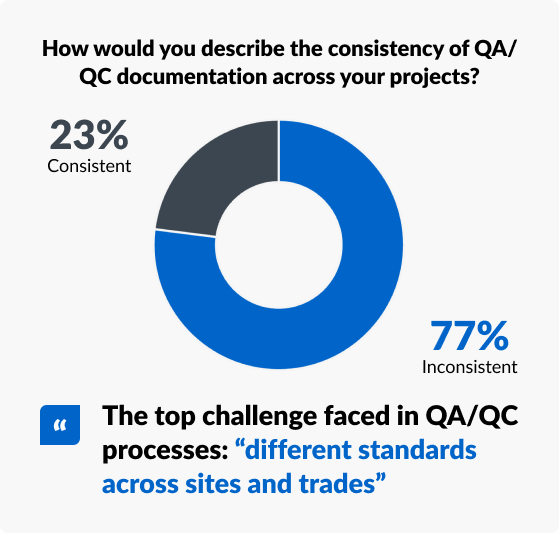
Inspections are one of the most important parts of quality assurance and safety management. They catch defects before handover, identify potential risks, and maintain compliance across every stage of construction.
But here’s the issue: many inspection processes stop short of actually driving change. Paper checklists, spreadsheets, or even static photos might capture issues, but they often fail to ensure that the right people take the right action at the right time.
In fact, according to PlanRadar’s Quality in Construction Report, over half of firms say that poor communication between teams delays issue resolution, costing both time and money.
Why “closing the loop” matters
Finding issues is only the first step. What really improves project outcomes is closing the loop—making sure every observation leads to action, verification, and documentation.
When inspection results aren’t linked to a clear workflow:
- Snags and safety hazards linger unresolved
- Data gets lost between teams or subcontractors
- The same mistakes reappear across projects
- Compliance evidence is incomplete or hard to find
Closing the loop ensures accountability, transparency, and continuous improvement. It transforms inspections from a “box-ticking exercise” into a process that genuinely improves quality and safety.
Step 1: Create clear responsibility chains
A successful inspection workflow assigns responsibility as soon as an issue is logged. With PlanRadar, each task can be allocated to a specific person or trade with due dates, priorities, and attachments—all visible in one shared platform.
This clarity eliminates ambiguity. Everyone knows what needs fixing, by whom, and when.
Step 2: Connect findings to fixes
A major reason why inspections stall is that teams use separate tools for capturing data, tracking work, and confirming completion. That fragmentation leads to missed actions.
By linking photos, notes, and checklists directly to digital tasks, PlanRadar makes it easy to turn findings into actions instantly. Whether it’s a cracked fire door, missing insulation, or a damp report, issues move from inspection to resolution in real time.
Step 3: Verify and document completion
Closing the loop doesn’t stop when the fix is done—it requires verification. PlanRadar’s built-in approval workflows and audit trail mean that once an issue is marked resolved, a manager or inspector can review and sign off instantly.
Every action, comment, and timestamp is logged automatically—providing tamper-proof evidence for compliance or handover documentation.
Step 4: Analyse and improve
Finally, use inspection data to identify patterns and prevent repeat issues. With PlanRadar’s analytics dashboard, teams can monitor trends across projects—spotting recurring defects or trades that need additional training.
This feedback loop transforms inspection data into actionable insight, supporting continuous improvement and reducing rework costs over time.
Closing the loop with PlanRadar
When inspection data leads directly to action, you don’t just catch problems—you prevent them. PlanRadar empowers construction teams to:
- Assign and track actions from inspection findings
- Monitor progress in real time
- Verify completion with photos and signatures
- Maintain a tamper-proof audit trail for compliance
By digitising inspections and linking every finding to a measurable outcome, you can finally close the loop—and ensure that every inspection drives tangible results.


